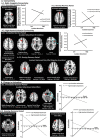Neural correlates of attachment in adolescents with trauma: a preliminary study on frustrative non-reward
- PMID: 35587099
- PMCID: PMC9714423
- DOI: 10.1093/scan/nsac038
Neural correlates of attachment in adolescents with trauma: a preliminary study on frustrative non-reward
Abstract
Despite the proposed early life origins of attachment style and its implications for risk for psychopathology, little is known about its neurodevelopmental course. Adolescence represents a key transition period when neural substrates of emotion regulation and reward undergo dramatic maturational shifts. Thus, maladaptive coping strategies associated with insecure attachment styles may have an exaggerated effect during adolescence. The current study, therefore, examined the neural correlates of insecure attachment in a diverse sample of adolescents using a frustrative non-reward task (i.e. repeatedly being denied an expected reward). Although there were no significant interactions in the whole-brain activation averaged over the course of the task, the use of complementary analytic approaches (connectivity, change in activation over the course of the task) revealed widespread alterations associated with avoidant attachment during the immediate reaction to, and ensuing recovery from, being denied a reward. Most strikingly, increased avoidant attachment, adjusting for anxious attachment, predicted functional connectivity and change in activity over time in amygdala-prefrontal and frontostriatal networks to reward blocked vs received trials. These patterns were in the opposite direction compared to those exhibited by adolescents lower in avoidant attachment. The findings suggest that negative emotional experiences, such as receiving frustrating feedback, may be uniquely aversive internal experiences for avoidantly attached adolescents and provide preliminary evidence that early coping strategies may persist into adolescence in the form of altered emotion- and reward-related neural patterns.
Keywords: adolescence; attachment; brain; emotion regulation; frustrative non-reward.
© The Author(s) 2022. Published by Oxford University Press.
Figures


Similar articles
-
Irritability-related neural responses to frustrative nonreward in adolescents with trauma histories: A preliminary investigation.Dev Psychobiol. 2021 Sep;63(6):e22167. doi: 10.1002/dev.22167. Epub 2021 Jul 22. Dev Psychobiol. 2021. PMID: 34292612
-
Contributions of childhood abuse and neglect to reward neural substrates in adolescence.Neuroimage Clin. 2021;32:102832. doi: 10.1016/j.nicl.2021.102832. Epub 2021 Sep 27. Neuroimage Clin. 2021. PMID: 34649067 Free PMC article.
-
The neural substrates of social emotion perception and regulation are modulated by adult attachment style.Soc Neurosci. 2012;7(5):473-93. doi: 10.1080/17470919.2011.647410. Epub 2012 Jan 5. Soc Neurosci. 2012. PMID: 22217336
-
[Risk-taking in adolescence: A neuroeconomics approach].Encephale. 2010 Apr;36(2):147-54. doi: 10.1016/j.encep.2009.06.004. Epub 2009 Sep 22. Encephale. 2010. PMID: 20434632 Review. French.
-
Investigating the Neural Encoding of Emotion with Music.Neuron. 2018 Jun 27;98(6):1075-1079. doi: 10.1016/j.neuron.2018.04.029. Neuron. 2018. PMID: 29953870 Review.
Cited by
-
Biomarkers for Cognitive Control, Response Inhibition, Aggressivity, Impulsivity, and Violence.Adv Neurobiol. 2024;40:725-756. doi: 10.1007/978-3-031-69491-2_24. Adv Neurobiol. 2024. PMID: 39562462 Review.
References
-
- Ainsworth M.D. (1985). Patterns of attachment. Clinical Psychologist, 38(2), 27–9.
-
- Amsel A. (1958). The role of frustrative nonreward in noncontinuous reward situations. Psychological Bulletin, 55(2), 102–19. - PubMed
-
- Ashwin C., Baron-Cohen S., Wheelwright S., O’Riordan M., Bullmore E.T. (2007). Differential activation of the amygdala and the ‘social brain’ during fearful face-processing in Asperger syndrome. Neuropsychologia, 45(1), 2–14. - PubMed
-
- Bowlby J. (1969/1982). Attachment and Loss, Vol. 1: Attachment. Attachment and Loss. New York: Basic Books.
Publication types
MeSH terms
LinkOut - more resources
Full Text Sources
Medical

